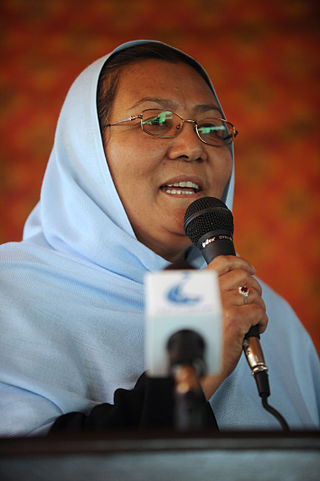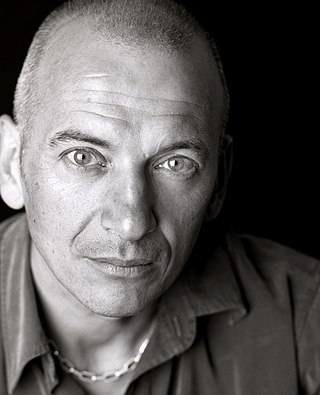
The Taliban, which also refers to itself by its state name, the Islamic Emirate of Afghanistan, is an Afghan political and militant movement with an ideology comprising elements of Pashtun nationalism and the Deobandi movement of Islamic fundamentalism. It ruled approximately 75% of Afghanistan from 1996 to 2001, before it was overthrown by an American invasion after the September 11th attacks carried out by the Taliban's ally al-Qaeda. The Taliban recaptured Kabul in August 2021 following the departure of coalition forces, after 20 years of Taliban insurgency, and now controls the entire country. The Taliban government is not recognized by any country and has been internationally condemned for restricting human rights, including women's rights to work and have an education.

Mullah Muhammad Omar was an Afghan mujahideen commander, revolutionary, and the cleric who founded the Taliban. During the Third Afghan Civil War, the Taliban fought the Northern Alliance and took control of most of the country, establishing the First Islamic Emirate for which Omar began to serve as Supreme Leader in 1996. Shortly after al-Qaeda carried out the September 11 attacks, the Taliban government was toppled by an American invasion of Afghanistan, prompting Omar to go into hiding. He successfully evaded capture by the American-led coalition before dying in 2013 from tuberculosis.
The following lists events that happened during 2001 in Afghanistan.

This article on the history of Afghanistan covers the period from the fall of the Najibullah government in 1992 to the end of the international military presence in Afghanistan.

Freedom of religion in Afghanistan changed during the Islamic Republic installed in 2002 following a U.S.-led invasion that displaced the former Taliban government.

The Islamic Emirate of Afghanistan, also referred to as the First Islamic Emirate of Afghanistan, was a totalitarian Islamic state led by the Taliban that ruled most of Afghanistan from 1996 to 2001. At its peak, the Taliban government controlled approximately 90% of the country, while remaining regions in the northeast were held by the Northern Alliance, which maintained broad international recognition as a continuation of the Islamic State of Afghanistan.

Bamyan Province, also spelled Bamiyan, Bāmīān or Bāmyān, is one of the thirty-four provinces of Afghanistan with the city of Bamyan as its center, located in central parts of Afghanistan.

Bamyan, also spelled Bamiyan or Bamian, is the capital of Bamyan Province in central Afghanistan. Its population of approximately 70,000 people makes it the largest city in Hazarajat. Bamyan is at an altitude of about 8,366 feet (2,550 m) above sea level. The Bamyan Airport is located in the middle of the city. The driving distance between Bamyan and Kabul in the southeast is approximately 180 kilometres (110 mi). The Band-e-Amir National Park is to the west, about a half-hour drive from the city of Bamyan.

The Buddhas of Bamiyan were two possibly 6th-century monumental Buddhist statues in the Bamiyan Valley of Afghanistan. Located 130 kilometres (81 mi) to the northwest of Kabul, at an elevation of 2,500 metres (8,200

The history of the Jews in Afghanistan goes back at least 2,500 years. Ancient Iranian tradition suggests that Jews settled in Balkh, an erstwhile Zoroastrian and Buddhist stronghold, shortly after the collapse of the Kingdom of Judah in 587 BCE. In more recent times, the community has been reduced to complete extinction due to emigration, primarily to Israel. At the time of the large-scale 2021 Taliban offensive, only two Jews were still residing in the country: Zablon Simintov and his distant cousin Tova Moradi. When the Islamic Emirate of Afghanistan was re-established by the Taliban in August 2021, both Simintov and Moradi made aliyah on 7 September 2021 and 29 October 2021, respectively, leaving Afghanistan completely empty of Jews. Today, the overwhelming majority of the Afghan Jewish community resides in Israel, with a small group of a few hundred living in the United States and the United Kingdom.

Bacha bāzī is a practice in which men buy and keep adolescent boys, or dancing boys, for entertainment and sex. Pederasty is a custom in Afghanistan and in historical Turkestan and often involves sexual slavery and child prostitution by older men of young adolescent males.

Dr. Habiba Sarābi is a hematologist, politician, and reformer of the reconstruction of Afghanistan after the Taliban first took power. In 2005, she was appointed Governor of Bamyan Province - the first Afghan woman to become a provincial governor. She had served as Afghanistan's Minister of Women's Affairs and as Minister of Culture and Education. Sarabi was instrumental in promoting women's rights and representation and environmental issues. She belongs to the ethnic Hazara people of Afghanistan. Her last name is sometimes spelled Sarobi.

Cinema was introduced to Afghanistan at the beginning of the 20th century. Political troubles, such as the 1973 Afghan coup d'état and the Saur Revolution slowed the industry over the years; however, numerous Pashto and Dari films have been made both inside and outside Afghanistan throughout the 20th century. The cinema of Afghanistan entered a new phase in 2001, but has failed to recover to its popular pre-war status.
Lida Abdul, is an Afghani-born video artist and performance artist. She was born as Lida Abdullah in Kabul in 1979, fled the country as a child during the Soviet Invasion, and went on to live in India and Germany then the United States.
Dr. Zemaryalai Tarzi is an archaeologist from Afghanistan.

Phil Grabsky is a British documentary film-maker.
Buddha Collapsed Out of Shame is a 2007 Iranian film directed by Hana Makhmalbaf. The title is taken from her father Mohsen Makhmalbaf's book The Buddha Was Not Demolished in Afghanistan, It Collapsed Out of Shame. The story takes place in modern Afghanistan following the removal of the Taliban and revolves around a 5-year-old Afghan girl who wants to attend a newly opened school. The girl Bakhtay lives in the caves under the remains of the Buddhas of Bamiyan which were destroyed by the Taliban in 2001. Bakhtay becomes obsessed with the idea of going to school but must fight against a society influenced by conditions suffered during the strict Taliban rule including male domination, war, poverty, violence and dire children's games.

Located on the strategic crossroads of Iran, India, China and Central Asia, Afghanistan boasts a diverse cultural and religious history. The soil is rich with archaeological treasures and art that have for decades come under threat of destruction and damage. Archaeology of Afghanistan, mainly conducted by British and French antiquarians, has had a heavy focus on the treasure filled Buddhist monasteries that lined the silk road from the 1st c. BCE – 6th c. AD. Particularly the ancient civilizations in the region during the Hellenistic period and the Kushan Empire. The world's oldest-known oil paintings, dating to the 7th c. AD, were found in caves in Afghanistan's Bamiyan Valley. The valley is also home to the famous Buddhas of Bamiyan.

The Boy Mir is documentary film about ten years life of a Hazara boy in Afghanistan. This film was made after an international hit film The Boy who Plays on the Buddhas of Bamiyan by a British film maker Phil Grabsky.
Afghanistan is uniquely situated as a throughway of cultures throughout its history due to it geographic placement in South Asia. Afghanistan's location lends porous borders to trade routes between the East and West, while the Silk Road providing a vector for Buddhism and Hellenistic culture and even Egyptian influences from the west, renders an amalgamation of culture and art. Perpetual invasion and conflict has rendered a cyclic continuum of renaissance and destruction of art and culture in Afghanistan.













